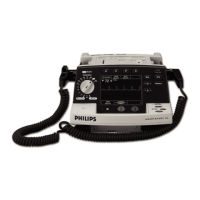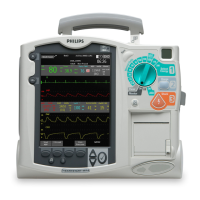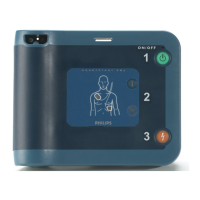Operational Problems
3-24 Troubleshooting
Charges, but disarms when press
SHOCK or paddles buttons.
Patient impedance sensed as too
high or too low during energy deliv-
ery due to:
• Pads/paddles losing contact with
patient.
• Pads/paddles failure.
• Pads cable failure.
Replace paddles, or pads and pads
cable.
Power PCA failure. Replace Power PCA.
Control PCA failure. Replace Control PCA.
Charges, but disarms spontane-
ously.
1. Unit sensed
Pads Off or Cable
Off
due to:
• Pads/paddles losing contact with
patient.
• Pads/paddles failure.
• Pads cable failure.
• Power PCA failure.
• Control PCA failure.
• Keyscan PCA failure.
2.
DISARM key failure (intermittent).
1. Replace paddles, or pads and
pads cable.
2. Diagnose further as follows:
In Diagnostic Mode, run Controls
Test and test
DISARM key.
• Key tests OK: Replace 1) Power
PCA 2) Control PCA.
• Key not OK: Replace 1) Keyscan
PCA 2) Bezel Assembly 3) Control
PCA.
Charges slowly - about 4-5 sec.
instead of 2-3 sec.
Battery too old or not fully charged. Replace with new, fully charged
battery. Also run Battery Capacity
Test on suspect battery (see
page 2-47).
Unit senses unsupported battery
due to:
• Unsupported battery in use.
• Battery PCA failure.
• Power PCA failure.
• Control PCA failure.
Use only supported battery
(M3516A/M5516A).
Diagnose further as follows:
In Diagnostic Mode, start Battery
Capacity Test (see page 2-47).
• “
Unsupported battery” on
display: Stop test. Replace
1) Battery PCA 2) Power PCA
3) Control PCA.
• No message on display: Stop test.
Replace 1) Power PCA 2) Control
PCA.
Doesn’t deliver correct energy into
Defibrillator Analyzer or delivers no
energy at all. (Should also get mes-
sage - No shock delivered or Defib
failure
.)
Control PCA failure. Replace Control PCA.
Power PCA failure. Replace Power PCA.
Table 3-9 Operational Problems - Defibrillation and Synchronized Cardioversion (Continued)
Message or Symptom Possible Causes Suggested solution

